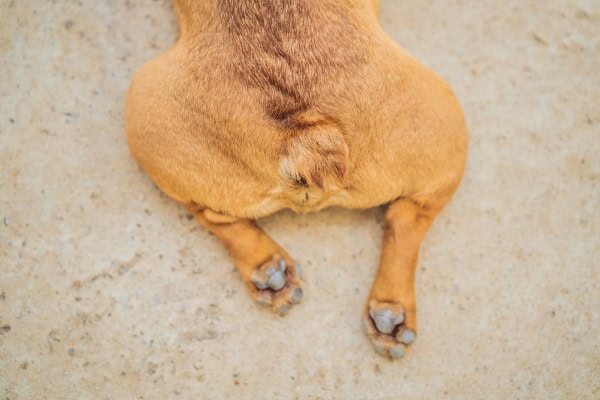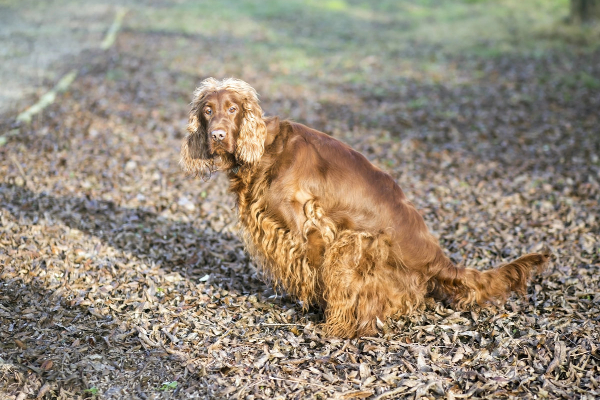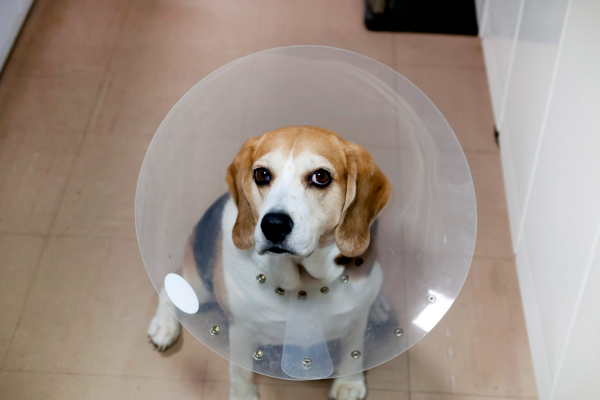Vaginitis in dogs (i.e. inflammation of the vagina and vestibule) can affect both puppies and adult dogs, regardless of whether they are spayed or intact. Integrative veterinarian Dr. Julie Buzby explains the types, causes, symptoms, diagnosis, and treatment of vaginitis in dogs so you know what to expect.

Sometimes vaginitis can make a dog itchy and uncomfortable. Other times it just causes some unsightly discharge. Vaginitis is typically is pretty harmless, but a few of the conditions that cause vaginitis can be dangerous. Therefore, vaginitis is important for dog parents to understand.
What is vaginitis in dogs?
Vaginitis in dogs is inflammation of the vagina and vestibule. The vestibule is the space just inside the external cone-shaped tissue that makes up the vulva of a female dog. And the vagina is the area between the vestibule and the cervix, or entryway to the uterus.
What causes vaginitis in dogs?
Vaginitis can affect spayed or intact female dogs of any age and comes in two forms—puppy vaginitis and adult-onset vaginitis. It may occur for a variety of reasons.
Causes of juvenile (puppy) vaginitis
Juvenile vaginitis is the more common of the two conditions and occurs in puppies under one year of age. The exact underlying cause is unknown. But experts suspect that having a hooded vulva and immaturity of the vaginal walls may make puppies more prone to vaginitis. Plus, food allergies and urine that is too acidic or too alkaline may also increase the risk of vaginitis.

Causes of adult-onset vaginitis
Dogs who develop vaginal inflammation after the age of one have adult-onset vaginitis. This type of vaginitis is more common in spayed females than intact females. And it can be further characterized as primary or secondary vaginitis.
Primary vaginitis occurs due to an overgrowth or alteration of normal vaginal bacteria. However, in the majority of affected adult dogs, vaginitis is usually secondary to another condition or problem.
Urinary tract infections
Approximately 26-60% of dogs with vaginitis will also have a urinary tract infection (UTI in dogs). It is possible that the UTI occurs first and then infected urine causes a vaginal infection. Or there is also the potential that the dog starts out with a vaginal infection which then makes its way up to the bladder and causes the UTI. It’s sort of a chicken and egg scenario.

Anatomical abnormalities
Abnormalities to the anatomy of the vulva, vestibule, or vagina occur in about 20-36% of cases of vaginitis. Some of of the more common issues include recessed vulva in dogs, narrowing of the vagina, or vaginal septa in dogs. The thought is that these changes may allow urine to pool in the vagina and vestibule, which leads to irritation.
Incontinence
In some dogs with incontinence in dogs, the urine soaked fur around the vulva plus vaginal irritation from dribbling urine creates a prime situation for vaginitis. The incontinence tends to be due to urethral sphincter mechanism incompetence, which is also known as spayed female incontinence. Alternatively, ectopic ureters can also cause incontinence and vaginitis. In this condition, the ureters, which should take urine from the kidneys to the bladder, will instead deposit urine somewhere in the vaginal vault.
Other conditions
Additionally, vaginitis may be due to:
- Vaginal foreign body
- Trauma to the vagina from birth or mating
- Vaginal tumors
- Contamination of the vestibule and vagina with urine or feces
- Viral infections like canine herpes virus
- Bacterial infections such as brucellosis
- Extension of skin infection that started around the vulva (i.e. perivulvar dermatitis)
- Changes in hormone levels
- Infections of the uterus
- Systemic diseases like diabetes in dogs or Cushing’s disease in dogs
- Idiopathic, meaning we don’t know the cause
What are the symptoms of vaginitis in dogs?
Puppy vaginitis is often an incidental finding. In other words, the vet notices some discharge gluing the vulva together while performing a puppy exam. But the puppy isn’t showing any other symptoms of vaginitis in dogs. However, sometimes the dog parent does notice some of the other signs listed below.
On the other hand, dogs with adult-onset vaginitis may show more symptoms, including:
Dog licking the vulva
The dog can’t get to the irritated and itchy vestibule or vagina to lick it, so she will often lick the vulva instead.
Scooting or rubbing the vulva
Vaginitis can be very itchy for dogs. Thus, they may try to scratch the itch by rubbing the area around the vulva against the ground.
Vaginal discharge
Approximately 60-90% of dogs with adult-onset vaginitis will have some sort of vaginal discharge. And the discharge is often the only finding in puppy vaginitis. It may be cloudy, yellowish, reddish, or mucoid. Especially in puppies, the discharge may stick the lips of the vulva together.
Inflammation of the vulvar folds
The vulva itself may be red and swollen. And the vestibule and vagina may look red or irritated too.
Irritation of the skin around the vulva
The skin surrounding the vulva may be red, brownish, or crusty, especially if the dog has a skin infection in that area.
Increased frequency of urination
It may seem like your dog has a UTI (and some actually do) because she is asking to go outside to urinate more often.
Being attractive to male dogs
Even if the dog is spayed, male dogs may suddenly be more interested in dogs with vaginitis.

Head to the vet
If you see these symptoms, it is a good idea to make an appointment with your veterinarian. Keep in mind that vaginal discharge plus systemic signs such as vomiting and being a lethargic dog might mean that your intact female dog actually has a life-threatening uterine infection called pyometra in dogs, not vaginitis. Thus, if your dog seems sick plus has vaginal discharge, make an emergency vet visit promptly.
How is vaginitis diagnosed?
Most of the time, the vet can diagnose your dog with vaginitis based on your dog’s symptoms and physical examination findings. However, in some cases, he or she may want to perform additional diagnostics. This is especially likely to be the case if your dog has been getting repeated cases of vaginitis or seems to be feeling sick.
For example, the vet may recommend a cystocentesis (i.e. obtaining a urine sample from the bladder) and urinalysis or urine culture to check for a UTI. This is the case because a free catch urine sample (one collected while the dog was urinating) would be contaminated with bacteria from the vagina. So it would be difficult to know if the dog had a UTI or just vaginitis.

If the vet suspects the dog has a pyometra or systemic disease, he or she may recommend blood tests for dogs and/or imaging such as an abdominal ultrasound or X-rays.
The vet may also perform a digital vaginal exam to feel for any masses, foreign objects, or anatomic abnormalities. Plus, it can be helpful to perform vaginoscopy, which involves visualizing the vestibule and vagina with a lighted cone (like the one used to check ears) or a camera. This also can be a useful way to evaluate the mucosa, anatomy, and contents of the vagina and vestibule.
Most of the time, bacterial cultures of the vagina are not useful because the vagina is not a sterile environment. However, there are some situations, such as a suspected vaginal bacterial infection, where cultures or cytology may give your vet additional helpful information.
How do you treat vaginitis in dogs?
The treatment plan for vaginitis depends on the type (puppy vs adult-onset), underlying cause, and whether or not the dog is showing any symptoms other than vaginal discharge.
Treatment for puppy vaginitis
If it was an incidental finding on a puppy exam, puppy vaginitis may not require any treatment. But if the dog is experiencing excessive discharge, licking of the vaginal area, or showing other signs that the vaginitis is bothering her, the vet may recommend treatment as discussed below in the adult-onset vaginitis section.
The good news about puppy vaginitis is that it will often resolve on its own after the dog goes through the first heat cycle or gets spayed.
For more severe cases of puppy vaginitis, some veterinarians feel that waiting to spay a dog until after her first heat cycle may help resolve the vaginitis. However, other vets may recommend still spaying before the first heat cycle to provide the lowest risk of mammary tumors, uterine infections, and unwanted pregnancies. Your veterinarian can help you make the best decision for your dog about the timing of the spay.
Treatment for adult-onset vaginitis
Part of treating adult-onset vaginitis involves addressing the underlying cause. For dogs with spayed female incontinence, hormonal replacement or other incontinence medications are helpful. Additionally, the vet may treat a UTI with antibiotics or remove foreign material from the vagina or vestibule.
Sometimes the dog may need surgery such as a vulvoplasty to remove excess skin around the vulva and correct the recessed vulva. Or dogs who have vaginitis secondary to a pyometra may need hospitalization and an urgent spay.
The other aspect of treating vaginitis in dogs is managing the vaginitis itself. Some possible treatments for vaginitis include:
- Antibiotics—if the vet suspects a vaginal infection or infection of the skin that makes up and surrounds the vulva
- Cleaning around the vulva with baby wipes or a medicated wipe several times a day
- Probiotics to support normal vaginal bacterial populations
- Anti-inflammatories or anti-itch medications
- An E-collar if the dog is causing trauma to the area by licking
- Estrogen replacement therapy to help support the vaginal mucosa

Please note, veterinarians typically do not recommend putting any products in the vagina or rinsing the vagina with antibacterial substances as it has not been proven to be effective.
Are there home remedies for vaginitis?
Some of the things on the list above make good home remedies for vaginitis. For example, it is pretty easy to get a pack of baby wipes and wipe around your dog’s vulva twice a day. Or you can pick up a dog probiotic at the veterinary clinic or pet store.
However, the important thing to remember with home remedies for vaginitis is that they are just intended for mild cases of vaginitis where the dog feels fine or as ways to help prevent vaginitis in the future. If your dog is acting sick or is bothered by symptoms, it is best to head to the vet for advice rather than trying home remedies first.
What is the outlook for dogs with vaginitis?
Thankfully, vaginitis often resolves well—either on its own or after treatment. Occasionally though, it will reoccur or not improve. If that happens, the next steps often involve more diagnostics to try to find and address the root cause. Additionally, your vet may talk to you about preventive measures such as wiping the area around the vulva.
Work with your veterinarian
If you are noticing your female dog has vaginal discharge, is licking her vulva excessively, scooting, or has changes in her urination frequency, please contact your vet promptly. Vaginitis itself is just annoying, not dangerous. However, conditions such as pyometra and UTI may cause vaginitis or have similar signs. And they are much more serious or even life-threatening. Thus, it is important to get your dog checked out quickly.
Hopefully, the answer is that your dog just has a simple case of vaginitis that resolves easily. But regardless of the diagnosis, by partnering with your vet, you can ensure that your dog gets the help she needs.
Has your dog ever had vaginitis?
Please share your experience below.


Thank you for the “Vaginitis in Dogs” article, it was very helpful for me in understanding causes & daily routines to continue with in caring for my elderly Dachshund (14 years old). I find using baby wipes for sensitive skin on her after she has urinated a very effective way in removing any foreign matter (she squats very very low to the ground) & generally cleaning any dribbles. She never suffered from vaginitis or UTI as a younger dog, but was prone to these after extended hospitalisation’s (spinal disc surgery, spleen & gallbladder removal).
Also knowing about puppy vaginitis was useful, as I’m getting a new puppy (8 weeks old) later in January 2025.
Thank you again for your website & articles. I’ve found them invaluable in life with my older dogs, & look forward to more with my puppy.
Hi Melissa,
Thank you for the kind words and great feedback about the article. It sounds like you have a great routine in place for your senior girl and she is very lucky to have you taking such good care of her. I wish you all the best as you welcome a new puppy into your family. Bless you all and keep up the good work!